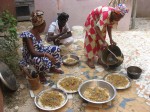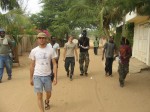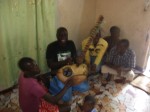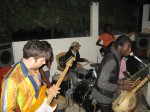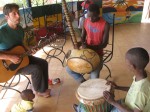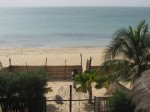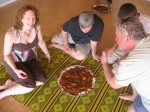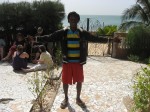Youssoufa’s Band at Kasumay
After writing these words, I took a voyage into the palace of my memory that is the resting place of my experiences. They are all in there somewhere and now I’m choosing which ones to share with y’all. I recently read an article by a memory athlete on how the technique of storing and recalling bits of information works. Briefly, each bit of information that you want to remember is associated with a visual image, and these images are stored together in locations that you can mentally walk through, such as a castle with lots of rooms or a garden with lots of plots.
For Senegal, I chose an old stone castle that I visited in Scotland in 1999. It was in ruin, but it still works for documenting this particular adventure. The chamber at the northwest corner of the castle represents Kairaba’s 4 separate trips to see Diali’s brother Youssoufa’s band play at Kasumay, a bar about 15 km north of Mbour in a town called Somone. Kasumay was dark and dusty, as was the chamber of the castle.
Youssoufa is Diali’s older brother, and heads up the band with his virtuosic kora playing. Diali relates that Youssoufa was next to their father a lot more often than he was, learning kora music and how to ply his trade as a jeli / griot. He plays with a fluidity and melody that is truly remarkable, and is very fluent in every traditional piece there is. However, with his band he plays new creations that he has build on top of the old.
His band is acoustic-style (but loud), with himself on electrified kora and vocals, Baba on electric bass, Kausu on the low and middle soruba drums, Kemu on dunduns (double-headed barrel-shaped drums played with sticks), and Ablaye on jembe and the high soruba. Often others join in, including the members of Kairaba quite frequently. The songs are long and like the ebb and flow of tides. The music ripples at your toes repeatedly, then suddenly it’s going down your throat and flooding the village. The tempos are slow, but the subdivisions are high; that is to say that the main groove could seat itself as a slow waltz, but when the dancers heat up, as they certainly do, the band is suddenly playing 32nd notes. At this, your blood begins to march faster through your veins so when you are pulled up to dance, you are ready to explode.
This was like going to school for Kairaba; like an internship. It was a very valuable experience, playing with such great, smooth, and friendly musicians. Throughout our trip, we continuously inspired each other, and neither side would accept that they were better than the other. I freely threw around words of flattery like maestro, maitre (teacher), patron, big boss, super étoile (superstar), as well as embellishing them with le grand… and le super…. This got me in trouble and had me permanently earmarked for the rest of the trip as maestro or maes (rhymes with nice) for short. Jabu, Diali’s 12-year-old sister, found it continuously funny.
Communication/Response
Back in the chamber inside the Scottish castle, there were a few white shells on the floor, dotting the darkness with a pale pearly din. This represents a moment at Kasumay that touches me every time I remember it. Kemu, the dundun player, is a tall, slender, intensely muscular fellow whose figure is sought after by many a lanky boy. He is very sweet and never hesitated to help me with anything I needed. But when he played, he was serious. His blank stare could win the world championships. But there was a moment when he departed from that stare that I found to be especially beautiful.
The band was playing at Kasumay on a dark, cool night with no lights on them. The music was rolling, beer was flowing, the public was into it, singing along and dancing in short bursts. A few whites were there, but it was mostly Senegalese. Ablaye, on jembe and high soruba, suddenly launched into a short burst of soloing, ending perfectly on the same beat with Kemu’s simultaneous and ornamental response to it on dunduns. Kemu cracked a smile, not a big one but like a ¾ one, showing his beautiful white teeth that were not yet darkened by the high sugar intake of his lifestyle. With this smile, he noted his pleasure at one of the most important aspects of playing that kind of music: communication/response. Ablaye called and Kemu answered, adding movement to the music and bringing into that dark and dusty scene an awesome moment of beauty.
Things to Love
1. The scene on the beach at dusk. Every evening, the beach would be flooded by buff men exercising tirelessly. Soccer matches in the deep sand, lutteurs (wrestlers) practicing, joggers going quite slow, men doing crazy push-ups in pits they had just dug, and the same men doing unbelievable backward squats up an incline. I didn’t last long at all in the soccer matches and the squats were just plain out of the question. So I just did some push-ups and then went for a benumbing swim in the cold sea.
2. Moulaye’s morning greeting. Moulaye is a relative of Diali who was very keen on practicing his few words of English, especially ones that he didn’t quite understand how to use. His shining moment, which became fodder for a joke that arose every hour, was when he walked up to John in his doorway one morning and blurted out “I’m fine?” Of course he meant to say ‘how are you’, but he got the question and response mixed up. Later he began to make fun of himself and even started embellishing: “I’m cool fine? I’m fine baby?”
3. The Baobab tree. You’ve heard of ‘em. These are the trees that inspire fantastical fairy tales where old wise owls live in huge old trees and inside is an endless world to be explored down and down and downwards. My living room could actually fit into a baobab trunk. Senegal is dotted with them, some parts more densely than others, and the drive from Dakar to Mbour provides plenty of eye candy à la Baobab. Unlike most other trees in West Africa, they are rarely cut down because the wood doesn’t burn well and the tree provides a slightly sweet white fruit that is dried, blended with juice and made into a nice refreshing drink, among other things. The bark is also sliced off in a vertical pattern and used for rope and provides access to the trunk where water is stored by the tree for the dry season. The leaves are also cooked down and used in dishes and medicines. Many cool things about this tree. I hope you get to see one one day.
4. Eating the repas of the day. I’ve already written about the food (see the entry containing the words “bomb-ass food”) but I’ll do it again dang it. The Senegalese eat a light breakfast and dinner, but the midday meal (the repas) is a serious undertaking. In some cases, the cooks will spend all day preparing it. Typically, everyone eats together on the floor from large platters, using their right hand. I noticed that the men usually assume a customary kneeling position that facilitates easy right-hand access to the platter while minimizing the occupation of real estate next to the platter (often there are a lot of people eating and space is limited). You can try it: start by standing, then kneel down so your butt is almost on the ground; before you fall over backwards, slide your right foot under your butt and rest your weight on your heel. There is also a custom of insisting your fellow eaters to never ever stop eating. Just try and stop eating (when you are full) and see what happens. You will get yelled at by people still eating (with their mouths full), fingers will point back at the platter you just relieved yourself of, and rest assured brows will be furrowed. The only thing to do is return fire the next day, and this will win you MAD cool points.
5. Supakanya. This is more like Things to Love/Hate. This is also under the food category, but it deserves it’s own numeral here on the blog. Supakanya is a dish that, unlike the dishes written about in the ‘bomb-ass food’ entry, wasn’t so popular with the toubabs (foreigners). I was hanging out with the cooks one day while they were preparing it, and I left the kitchen confused and despondent. It’s a red sauce with okra and lots of strange stuff from the sea. I watched as Ami Cole, head chef, dumped tiny bag after tiny bag of strange powders and dried seafood bits into the bubbling goo. I questioned her about the contents and it was always “c’est ______, c’est quelques choses de la mer” (it’s _____, something that comes from the sea). I soon stopped asking and felt content that I at least recognized some small, dried shrimps. The dish is Diali’s favorite and he was ever so excited to eat it for the first time in two years.
6. Music was everywhere, all the time.
